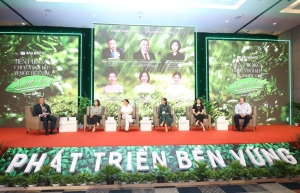Banking on banks to finance the green transition
Climate change is one of the most urgent and complex issues of our times. The stakes are especially high for Vietnam, where coastal communities are increasingly susceptible to rising sea levels, storms like September’s Typhoon Yagi, and the country’s agriculture sector is severely impacted by shifting rainfall patterns, among others. Addressing these concerns is crucial for the nation.
 |
| Thomas Jacobs, country manager for Vietnam, Cambodia, and Laos at the International Finance Corporation |
With its goal of reaching high-income status by 2045, Vietnam has made strong commitments to reduce methane emissions by 30 per cent from 2020 levels by 2030, phase out coal power by 2040, and achieve net-zero emissions by 2050. Achieving these goals will require significant financial investments, estimated at $368 billion from 2022 to 2040 per the World Bank Group’s Country Climate and Development Report for Vietnam.
This means around $20 billion per year in investments, with at least half of the funding expected to come from the private sector due to constrained public resources.
While climate finance is key to the country’s clean energy transition, progress has been slow. As of June 2024, only 5.4 per cent of the banking sector’s credit balance was allocated to climate-related initiatives, around $27.6 billion and green bonds worth only $1.16 billion were issued between 2019 and 2023.
This can be attributed to several challenges, including the absence of a clear taxonomy, inadequate capital market infrastructure, and limited capacity of banks to finance green portfolios.
Against this backdrop, banks in Vietnam have a key role to play. While waiting for guidance from the government, it is imperative they are proactive and stay ahead in the emerging climate finance market. By doing so, banks can contribute to Vietnam’s green transformation and seize the new business opportunities that climate finance offers.
BUILDING CAPACITY
Equipping the domestic financial sector is key so that it can assess opportunities and roll out the instruments – from green and blue bonds to sustainability-linked and transition finance – that are needed to scale climate finance.
As a starting point, banks can set up their own systems and frameworks. While helping them align with international best practices, it will enable them to scale up their green finance portfolio. A framework refers to a set of policies, guidelines, and procedures that outline a bank’s approach to integrating climate finance and environmental, social, and governance considerations into its lending, investment, and risk management practices.
Such an approach, especially in the absence of a national taxonomy, will allow banks to balance sustainability goals and economic targets, align internal performance with public commitments of greening the economy, and guide credit decisions. Also, banks will be able to define eligibility criteria for green projects while referring to other taxonomies such as ASEAN taxonomy, the International Capital Market Association guidelines, and using common frameworks of multilateral development banks. Going forward, this will help local banks to adjust and adapt quickly once an official taxonomy is in place.
From developing sustainable finance frameworks to boosting green finance capacity through training, in partnership with the Australian government, the International Finance Corporation (IFC) is already technically supporting several banks including ACB, OCB, HDBank, and VPBank in Vietnam depending on their needs, setting a trend.
RISK MANAGEMENT
As banks prepare to scale up their green lending operations, it is crucial they upgrade their internal procedures to monitor new types of climate risks – transition and physical. The first includes risks related to policy shifts, technology changes, and others, and the latter includes risks related to extreme weather events such as floods, droughts, and landslides.
By establishing clear metrics for assessing the environmental impact of their loans, banks can ensure their funding is channelled towards projects that genuinely contribute to decarbonisation and sustainability. Additionally, identifying potential areas of risk early on will allow them to take proactive measures to tackle any unexpected challenges.
Such a systematic approach not only facilitates effective scaling of green financing but also ensures banks can drive their growth strategy in the right direction, enhancing the overall impact of green financing, not only towards environmental sustainability but also in terms of the banks’ bottom line.
For instance, Amsterdam-based ING was one of the five international banks in 2018 that pledged, along with BBVA, BNP Paribas, Société Générale, and Standard Chartered, to develop an open-source methodology to gradually align their lending portfolios with the goals of the Paris Agreement.
By partnering with various climate think tanks, the bank developed the ‘Terra approach’, which combines a portfolio-level approach to the carbon-intensive sectors to measure and steer their loan book towards preset decarbonisation targets. In 2022, the bank successfully mobilised €101.3 billion ($109 billion) to support clients’ transition to sustainable business models.
DIVERSIFICATION OF FUNDING
Tapping into new funding sources can help alleviate the funding pressure on Vietnam’s traditional loan markets. By diversifying financing instruments, banks can mobilise new sources of capital and spread the risk associated with funding green projects. A strategic expansion of capital markets can foster a more robust and flexible financing landscape, vital for Vietnam’s climate and sustainability goals.
Sustainable bonds are a good example. They are financial instruments which raise funds specifically for projects with environmental or social impact. In Indonesia, the IFC invested up to approximately $200 million in the country’s first privately placed sustainable bond. This was the nation’s first gender bond, setting an example for future gender and green finance markets.
Similarly, the IFC supported BDO and TTB in the Philippines and Thailand, respectively, on their inaugural blue bond issuances. In Vietnam, the IFC has played a crucial role in introducing sustainable bonds to local financial institutions. This includes the collaboration with SeABank to launch the first-ever blue bond in the country.
Another new funding avenue gaining traction are green deposits, where banks commit to channelling capital into environmental-friendly projects. Globally, several banks offer this product. In Vietnam, BIDV became the first local bank to offer a green deposit product. By August 2024, in just over two months since the launch, BIDV successfully raised $200 million equivalent in green deposits.
Development finance institutions (DFIs) play an important part in creating markets, especially with those committing to increase their climate and green lending in emerging markets. For the IFC, we committed ourselves to align 85 per cent of all new investments starting July 2023 – and from July 2025 to align 100 per cent with the Paris Agreement. As Vietnam focuses on green transformation, DFIs, along with foreign investment flows, can play a pivotal role in providing funding for green projects.
Climate change is one of the defining challenges of our time, and Vietnam has prioritised sustainable development as central to its path towards a more resilient and greener future. Given the critical role the banking sector has in channelling capital to productive, green and sustainable investments, we are all ‘banking on banks’ to step up and help lead the way.
 | Green consumption trends on the rise in Vietnam Green consumption is rapidly gaining momentum in Vietnam thanks to increased awareness of environmental protection and sustainability, impacting consumer purchasing habits and presenting both opportunities and challenges for businesses, particularly small- and medium-sized enterprises (SMEs). |
 | Sustainability commitment deemed key for businesses to break barriers Pioneering companies from various sectors shared their journey in spearheading green and digital transformation at a VIR sustainable development conference on November 12. |
 | Green-digital transition must start with proper mindset Firms are emphasising that effectively implementing green-digital transition strategies depends on understanding the core issues and priorities of the company, rather than merely following current trends. |
What the stars mean:
★ Poor ★ ★ Promising ★★★ Good ★★★★ Very good ★★★★★ Exceptional
Related Contents
Latest News
More News
- Tax sector wraps up 2025 and sets priorities for next year (December 25, 2025 | 14:00)
- A tipping point for digital and hybrid wealth management in Vietnam (December 23, 2025 | 13:33)
- $250 million deal targets women-owned SMEs, sustainable agriculture (December 22, 2025 | 17:40)
- Stock market posts resilient 2025 performance (December 19, 2025 | 18:17)
- Citi Vietnam receives 2025 AmCham CSR recognition (December 19, 2025 | 16:35)
- As global green supply chain reshapes, will Vietnam be left behind? (December 19, 2025 | 08:00)
- Banks gear up for massive capital increases (December 18, 2025 | 17:04)
- Securing capital and efficiency for Vietnam’s 2026-2030 growth ambitions (December 17, 2025 | 10:00)
- Energy sector in need of blended finance mechanisms (December 17, 2025 | 09:00)
- Vietnam still has room to mobilise capital for sustainable growth (December 17, 2025 | 08:57)

 Tag:
Tag:





















 Mobile Version
Mobile Version